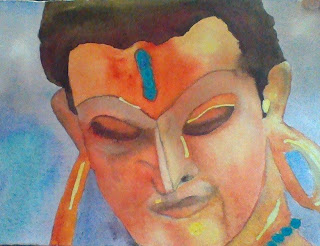***
Our yearning for what
Our yearning for what
we can not see is soothed by
our remembering.
The musings from the booster seat in back on the passenger side came out as words far beyond her usual language or understanding. As she looked out the car window on the ride home from softball she said softly, "Ours is a family that can never see the stars come out at night." This was followed by a sigh that was audible over NPR's low drone on the radio.
She, her sister, and I rode in silence after her profound statement. It seemed like such a large statement for such a small person. The words were so sad, like a foreshadowing first line in a novel. What would we learn about this family that would never see the stars come out. I reached over and turned the radio off, eager to hear the words that she might utter next.
I glanced at her in the rear view mirror. She was gazing out her window, looking at the sky through the filter of the small town scenery that we were driving through. A gas station, the bank, a box store, and some fast food places. Her usual comments about letters and words and wondering if we could "go there" were absent. There was a look of melancholic resignation in her gaze. Then another loud sigh.
My first reactions were to throw out some fix-its to her. I wanted to ask her why her family could never see the stars come out. Or worse yet, I wanted to alter her reality and tell her all the ways her family probably had and could continue to see the stars come out at night. But her tiny body was emitting the most amazing acceptance of this sadness. There was a sacredness in simply being in her presence. It was too sacred to correct with adult interference. Another loud sigh.
Suddenly, her older sister who'd been a silent holder of the statement as well, piped up, "That's right! We go too bed too early to see the stars come out in summer. But next winter, we'll see 'em again when we're eating supper!"
My laughter became the tenor for their chorus of high pitched cheers for the cycle of the seasons. As calm and order settled back into the car I said, "Isn't it amazing how the Universe works?" More cheers rose from the backseat, intermingled with each of us calling out our favorite planets, and constellations, and seasons.
"Let's celebrate," suggested the older, more sage sibling, "with frozen yogurt!" There was no pause for approval of the plan. Instead, more cheers followed, this time intermingled with calling out our favorite toppings and our hopes for the day's flavors.
As we walked across the parking lot of the local frozen yogurt shop, I did a quick scan of the turquoise sky for a star. I came up empty. No matter, I carry all the brilliance of the Universe in small seats in the back of my car.
(My early years in rural South Dakota gave me many opportunities to view the stars. I love the time-lapse photography of Randy Halverson, a farmer from Kennebec, South Dakota. His video at the top of this log reminds me of those times.)








